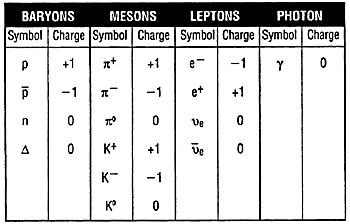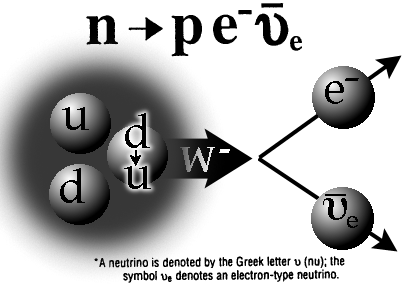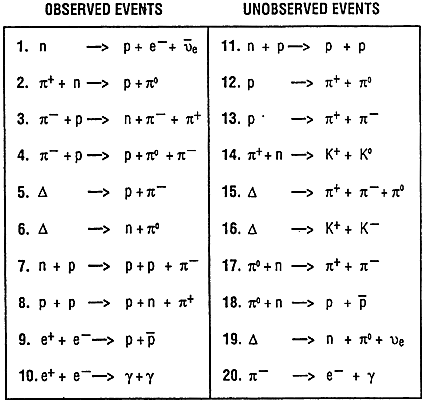
The most common type of observation in particle physics is called an event. An event is similar to a chemical reaction in chemistry, in the sense that one set of particles is formed from another.
The following particle charts can help you identify the types and charges of particles in a number of events given below. As indicated, each particle can have an electrical charge of +1, -1, or 0.
Note that antiparticles are denoted by a bar over the name of the particle (e.g., p-bar = antiproton, nu-bar sub-e = antielectron -- neutrino); or simply by the charges (e- = electron, e+ = positron = antielectron); pi+ and pi- are particle and antiparticle, and similarly K+ and K-. An antiparticle has the same mass as its corresponding particle, but the opposite value for all charges.

Two sets of particle events are shown in the table at right. The set in the left column consists only of events that are known to take place, and the set in the right column consists only of events that are believed not to take place (they've never been observed). By examining the two sets, along with the preceding chart of particles, we must determine what quantities are or are not conserved in these particle physics events. These are the "rules of the game" played by nature.
All of the quantities whose conservation can be deduced from the following events can be found by counting. All such quantities are conserved in every "observed" event, but at least one of these quantities is not conserved in each "unobserved" event. Assume that the incoming particles have sufficient energy to generate the outgoing particles.


1. What is meant when we say that a quantity is
"conserved?"
___________________________________________
___________________________________________
___________________________________________
2. What quantities or numbers of object types are
conserved?
a) _____________________
b) _____________________
c) _______________________
3. What is an "event" in particle physics?
___________________________________________
___________________________________________
___________________________________________
4. Which of the above events are decays?
___________________________________________
___________________________________________
5. For each of the unobserved events, indicate what is
not conserved (there may be more than one answer).
Event #:
11: _______________ 16: _______________
12: _______________ 17: _______________
13: _______________ 18: _______________
14: _______________ 19: _______________
15: _______________ 20: _______________